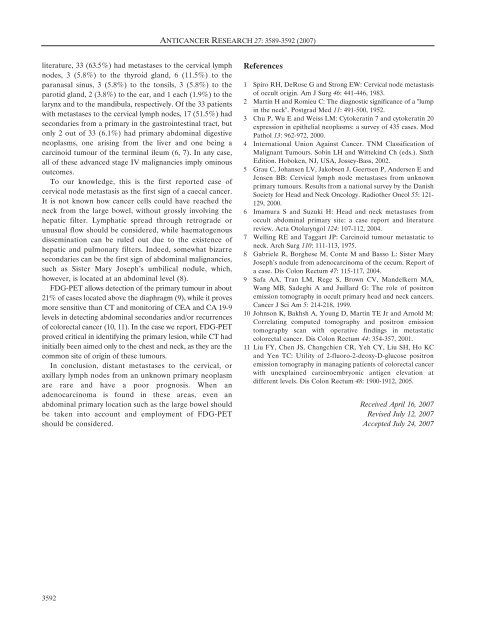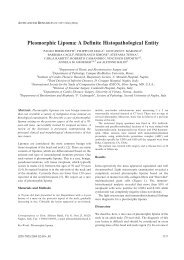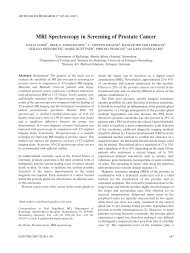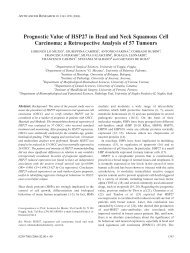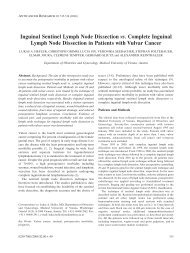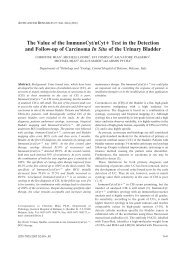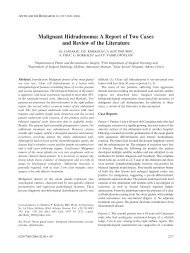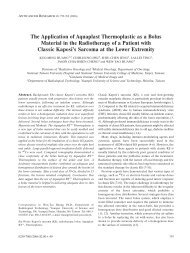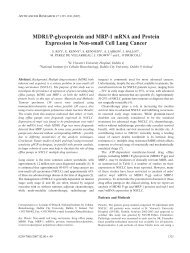Cervical Node Metastasis as the First Sign of Cancer of the Caecum
Cervical Node Metastasis as the First Sign of Cancer of the Caecum
Cervical Node Metastasis as the First Sign of Cancer of the Caecum
You also want an ePaper? Increase the reach of your titles
YUMPU automatically turns print PDFs into web optimized ePapers that Google loves.
literature, 33 (63.5%) had met<strong>as</strong>t<strong>as</strong>es to <strong>the</strong> cervical lymph<br />
nodes, 3 (5.8%) to <strong>the</strong> thyroid gland, 6 (11.5%) to <strong>the</strong><br />
paran<strong>as</strong>al sinus, 3 (5.8%) to <strong>the</strong> tonsils, 3 (5.8%) to <strong>the</strong><br />
parotid gland, 2 (3.8%) to <strong>the</strong> ear, and 1 each (1.9%) to <strong>the</strong><br />
larynx and to <strong>the</strong> mandibula, respectively. Of <strong>the</strong> 33 patients<br />
with met<strong>as</strong>t<strong>as</strong>es to <strong>the</strong> cervical lymph nodes, 17 (51.5%) had<br />
secondaries from a primary in <strong>the</strong> g<strong>as</strong>trointestinal tract, but<br />
only 2 out <strong>of</strong> 33 (6.1%) had primary abdominal digestive<br />
neopl<strong>as</strong>ms, one arising from <strong>the</strong> liver and one being a<br />
carcinoid tumour <strong>of</strong> <strong>the</strong> terminal ileum (6, 7). In any c<strong>as</strong>e,<br />
all <strong>of</strong> <strong>the</strong>se advanced stage IV malignancies imply ominous<br />
outcomes.<br />
To our knowledge, this is <strong>the</strong> first reported c<strong>as</strong>e <strong>of</strong><br />
cervical node met<strong>as</strong>t<strong>as</strong>is <strong>as</strong> <strong>the</strong> first sign <strong>of</strong> a caecal cancer.<br />
It is not known how cancer cells could have reached <strong>the</strong><br />
neck from <strong>the</strong> large bowel, without grossly involving <strong>the</strong><br />
hepatic filter. Lymphatic spread through retrograde or<br />
unusual flow should be considered, while haematogenous<br />
dissemination can be ruled out due to <strong>the</strong> existence <strong>of</strong><br />
hepatic and pulmonary filters. Indeed, somewhat bizarre<br />
secondaries can be <strong>the</strong> first sign <strong>of</strong> abdominal malignancies,<br />
such <strong>as</strong> Sister Mary Joseph’s umbilical nodule, which,<br />
however, is located at an abdominal level (8).<br />
FDG-PET allows detection <strong>of</strong> <strong>the</strong> primary tumour in about<br />
21% <strong>of</strong> c<strong>as</strong>es located above <strong>the</strong> diaphragm (9), while it proves<br />
more sensitive than CT and monitoring <strong>of</strong> CEA and CA 19-9<br />
levels in detecting abdominal secondaries and/or recurrences<br />
<strong>of</strong> colorectal cancer (10, 11). In <strong>the</strong> c<strong>as</strong>e we report, FDG-PET<br />
proved critical in identifying <strong>the</strong> primary lesion, while CT had<br />
initially been aimed only to <strong>the</strong> chest and neck, <strong>as</strong> <strong>the</strong>y are <strong>the</strong><br />
common site <strong>of</strong> origin <strong>of</strong> <strong>the</strong>se tumours.<br />
In conclusion, distant met<strong>as</strong>t<strong>as</strong>es to <strong>the</strong> cervical, or<br />
axillary lymph nodes from an unknown primary neopl<strong>as</strong>m<br />
are rare and have a poor prognosis. When an<br />
adenocarcinoma is found in <strong>the</strong>se are<strong>as</strong>, even an<br />
abdominal primary location such <strong>as</strong> <strong>the</strong> large bowel should<br />
be taken into account and employment <strong>of</strong> FDG-PET<br />
should be considered.<br />
3592<br />
ANTICANCER RESEARCH 27: 3589-3592 (2007)<br />
References<br />
1 Spiro RH, DeRose G and Strong EW: <strong>Cervical</strong> node met<strong>as</strong>t<strong>as</strong>is<br />
<strong>of</strong> occult origin. Am J Surg 46: 441-446, 1983.<br />
2 Martin H and Romieu C: The diagnostic significance <strong>of</strong> a "lump<br />
in <strong>the</strong> neck". Postgrad Med 11: 491-500, 1952.<br />
3 Chu P, Wu E and Weiss LM: Cytokeratin 7 and cytokeratin 20<br />
expression in epi<strong>the</strong>lial neopl<strong>as</strong>ms: a survey <strong>of</strong> 435 c<strong>as</strong>es. Mod<br />
Pathol 13: 962-972, 2000.<br />
4 International Union Against <strong>Cancer</strong>. TNM Cl<strong>as</strong>sification <strong>of</strong><br />
Malignant Tumours. Sobin LH and Wittekind Ch (eds.). Sixth<br />
Edition. Hoboken, NJ, USA, Jossey-B<strong>as</strong>s, 2002.<br />
5 Grau C, Johansen LV, Jakobsen J, Geertsen P, Andersen E and<br />
Jensen BB: <strong>Cervical</strong> lymph node met<strong>as</strong>t<strong>as</strong>es from unknown<br />
primary tumours. Results from a national survey by <strong>the</strong> Danish<br />
Society for Head and Neck Oncology. Radio<strong>the</strong>r Oncol 55: 121-<br />
129, 2000.<br />
6 Imamura S and Suzuki H: Head and neck met<strong>as</strong>t<strong>as</strong>es from<br />
occult abdominal primary site: a c<strong>as</strong>e report and literature<br />
review. Acta Otolaryngol 124: 107-112, 2004.<br />
7 Welling RE and Taggart JP: Carcinoid tumour met<strong>as</strong>tatic to<br />
neck. Arch Surg 110: 111-113, 1975.<br />
8 Gabriele R, Borghese M, Conte M and B<strong>as</strong>so L: Sister Mary<br />
Joseph's nodule from adenocarcinoma <strong>of</strong> <strong>the</strong> cecum. Report <strong>of</strong><br />
a c<strong>as</strong>e. Dis Colon Rectum 47: 115-117, 2004.<br />
9 Safa AA, Tran LM, Rege S, Brown CV, Mandelkern MA,<br />
Wang MB, Sadeghi A and Juillard G: The role <strong>of</strong> positron<br />
emission tomography in occult primary head and neck cancers.<br />
<strong>Cancer</strong> J Sci Am 5: 214-218, 1999.<br />
10 Johnson K, Bakhsh A, Young D, Martin TE Jr and Arnold M:<br />
Correlating computed tomography and positron emission<br />
tomography scan with operative findings in met<strong>as</strong>tatic<br />
colorectal cancer. Dis Colon Rectum 44: 354-357, 2001.<br />
11 Liu FY, Chen JS, Changchien CR, Yeh CY, Liu SH, Ho KC<br />
and Yen TC: Utility <strong>of</strong> 2-fluoro-2-deoxy-D-glucose positron<br />
emission tomography in managing patients <strong>of</strong> colorectal cancer<br />
with unexplained carcinoembryonic antigen elevation at<br />
different levels. Dis Colon Rectum 48: 1900-1912, 2005.<br />
Received April 16, 2007<br />
Revised July 12, 2007<br />
Accepted July 24, 2007


